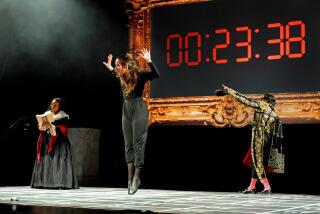A Moment in Sun for Fiddling Phenoms
For the hugely hyped Russian-born Israeli violinist Maxim Vengerov, creating a stir has become old hat, despite his mere 18 years. Vengerovâs just-released showpiece program (Teldec 73266) is likely to win him even more friends.
What fun it is to hear Vengerov tear into the pyrotechnics of Paganiniâs D-major Concerto with such gleeful abandon and then play its more subdued passages with such care (but not to the point of studiedness) and sweetly rotund tone. His efforts are backed by the Israel Philharmonic under Zubin Mehtaâs energetic direction.
Further pleasures are provided by Vengerovâs uncloyingly warm playing of those ultimate showpieces for the sensitive virtuoso, Saint-Saensâ âIntroduction et Rondo Capricciosoâ and âHavanaise.â
If the young man doesnât show the demonic bite of a Jascha Heifetz in Franz Waxmanâs delectably vulgar âCarmen Fantasy,â well, thereâs only one Heifetz--and perhaps only one Vengerov, who might steal even more hearts if he emerged as the charismatic young phenom who returned portamento to its rightful place among the important expressive ornaments of the Romantic style.
A simultaneous coupling (Teldec 74001) of Beethovenâs âKreutzerâ Sonata with the A-major Sonata of Brahms, which seems predicated on showing Vengerovâs âmaturity,â is not well chosen for a performer of his tender years.
In both vibrato-laden, relentlessly loud performances (Teldecâs close-up recording is a contributory factor) the violinist sounds less comfortable than his seasoned pianist, Alexander Markovich. At this stage, Vengerov does not seem willing or able to speak intimately.
Whatever attention-grabbing silliness may have become part of Nigel Kennedyâs image, there is strength of purpose and a keen intelligence at work in his recorded interpretation of the Sibelius Concerto, in which his ideas are superbly seconded by Simon Rattle and the City of Birmingham Symphony.
This reissued 1988 recording, fitted out with a new, Kennedy-as-renegade cover photo to take advantage of the soloistâs current crossover celebrity, also contains the Tchaikovsky Concerto, which first appeared in 1986 and in which Kennedy is unable to make any forceful statement in the face of Okko Kamuâs appallingly sluggish conducting of the London Philharmonic (EMI Classics 54559).
That the Sibelius has become the Romantic Concerto of Choice among todayâs young virtuosi is further substantiated by a recording from American violinist Joseph Swensen.
While there is no shortage of skill or sensitivity on display here, a certain interpretive stolidity is also suggested, a refusal to really let go in the concertoâs most dramatic moments.
Swensenâs experience as a chamber music player is, however, apparent in the Sibelius miniatures for violin and orchestra that complete the program. His stylish, helpful collaborators throughout are the Finnish Radio Symphony, conducted by Jukka-Pekka Saraste (RCA Victor Red Seal 604444).
Simultaneously released on RCA, but at mid-price to Swensenâs top-dollar disc (what are the record companies doing to themselves?), is a reissue of Gidon Kremerâs wonderfully deep, dark, risk-taking 1977 version of the Sibelius Concerto, with Gennady Rozhdestvenskyâs probing conducting of the London Symphony creating an ideal partnership (RCA Victor Gold Seal 60957).
The coupling is Alfred Schnittkeâs Concerto Grosso No. 1 of 1977, performed by dedicatees Kremer and his then-wife, violinist Tatiana Grindenko.
Fifteen years ago Schnittkeâs stylistic jumbles, exemplified by this chilling, superbly crafted work, had not as yet taken on the aura of compositional shtick.
And speaking of shtick, this time in performance, consider Anne-Sophie Mutterâs account of Bartokâs Second Violin Concerto: with a vibrato sufficiently wide to permit the passage of several motorized vehicles and the alternation of stagily hyper-soft playing with attacks violent enough to suggest a lethal assault on her precious Strad.
It is self-display, at the expense of Bartok and the polished backing of the Boston Symphony, conducted by that underappreciated prince of accompanists Seiji Ozawa.
The coupling (on Deutsche Grammophon 431 626) is the wishy-washy-dreamy âEn reveâ by Swiss composer Norbert Moret (b. 1921), written for Mutter in 1988 and reminiscent of Takemitsuâs delicate timbres, if not his purposefulness.
Two recent historic reissues of which the reader should be aware in this context: EMI Classics offers (64030, mid-price) Heifetzâs fabulous mid-1930s recordings of the Sibelius and Tchaikovsky Concertos, conducted, respectively, by Sir Thomas Beecham and the not-yet-knighted John Barbirolli, with the Glazunov Concerto a bonus.
Biddulph Recordings (LAB 051) offers an ear-opening Paganini program consisting of the D-major Concerto, played with irresistible panache (and acutely gauged portamento) in 1934 by Yehudi Menuhin, with Georges Enesco conducting; the first movement of the same work in the giddily showy arrangement by Wilhelmj, with his brief cadenza replacing the mighty monster by Emile Sauret usually played, executed in 1940 with appropriate sizzle by erstwhile American child prodigy Guila Bustabo, and Fritz Kreislerâs hilariously overorchestrated pastiche based on the D-major Concerto, with infusions of Sarasate--the whole tasty mess played (in 1936) by Kreisler with gorgeous tone and occasionally cavalier intonation.
More to Read
The biggest entertainment stories
Get our big stories about Hollywood, film, television, music, arts, culture and more right in your inbox as soon as they publish.
You may occasionally receive promotional content from the Los Angeles Times.










